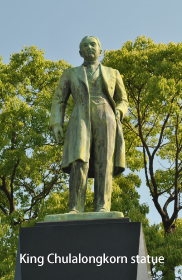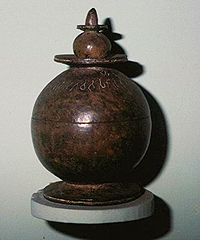>> Summary >> History of Nittaiji >> Precinct guide of Nittaiji
Nittaiji is the only temple in Japan that does not belong to any specific sect but represents all the sects.
 The holy remains of Buddha were provided from Thailand (then Siam) and Nittaiji(then Nissenji) was built in 1904 with agreement of the representatives of all the Buddhist sects.Under the name of ”Kakuo” representing Buddha, Kakuozan Nissenji was built by the symbol of friendship between Japan and Siam.Afterwards, Nissenji changed the name as Nittaiji in accordance with changing the name of the country from Siam to Thailand in 1939.
The holy remains of Buddha were provided from Thailand (then Siam) and Nittaiji(then Nissenji) was built in 1904 with agreement of the representatives of all the Buddhist sects.Under the name of ”Kakuo” representing Buddha, Kakuozan Nissenji was built by the symbol of friendship between Japan and Siam.Afterwards, Nissenji changed the name as Nittaiji in accordance with changing the name of the country from Siam to Thailand in 1939.
The administration of Nittaiji is managed by 19 Buddhist sects alternatively every three years. In this sense, chief priest is chosen among 19 sects.
As the annual event, Nirvana assembly March 15th,Buddha’s birthday assembly April 8th, Vesak festival May, memorial ceremony for enshrinement of Buddha’s holy remains June 15th, opening memorial of the temple November 15th, Buddha’s attainment assembly December 8th, spring and autumn equinox assembly, and so on.Kobo Daishi(great master) fair of 21st of every month is crowded all day and many stalls open on the precinct of Nittaiji. In this sense, Nittaiji is the relaxation place of the citizen of Nagoya.
In 19th century ,a major discovery was made in the Orient proving the existence of Buddha.
 In January 1898 , close to the border of Nepal at Pipurahwa, William Peppe, British residence officer found a pot of soapstone with human remains contained during excavation of ancient tombs.The ancient character of 3rd century B.C was carved on the surface of the pot. It said”The pot of the holy remains of Buddha is enshrined with a heart of trust by wife, children, brothers and sisters, together with a Sakya clan in India, Sakya”.The early Buddhism text stated that after Buddha passed away, he was cremated and the remains were deified and divided into eight. Sakya clan obtained a part of holy remains and enshrined at Kapila-Vastu. This proves that the description of the text is true.Among scholars of Western Europe in the 19th century at that time, they believed that Buddha was imaginary person and some scholars considered that worship of Buddha is a ritual of solar myth.Excavation and existence of Buddha’s holy remains transformed the religious world. Therefore, this incident was one of the major discovery in the 19 century in the East.
In January 1898 , close to the border of Nepal at Pipurahwa, William Peppe, British residence officer found a pot of soapstone with human remains contained during excavation of ancient tombs.The ancient character of 3rd century B.C was carved on the surface of the pot. It said”The pot of the holy remains of Buddha is enshrined with a heart of trust by wife, children, brothers and sisters, together with a Sakya clan in India, Sakya”.The early Buddhism text stated that after Buddha passed away, he was cremated and the remains were deified and divided into eight. Sakya clan obtained a part of holy remains and enshrined at Kapila-Vastu. This proves that the description of the text is true.Among scholars of Western Europe in the 19th century at that time, they believed that Buddha was imaginary person and some scholars considered that worship of Buddha is a ritual of solar myth.Excavation and existence of Buddha’s holy remains transformed the religious world. Therefore, this incident was one of the major discovery in the 19 century in the East.
Indian Government Office received the offer of some grave goods of this reliquary pot and then, these goods were delivered to Kolkata (then Calcutta) museum.Remains of holy bones were donated to the Royal Family of Thailand(then Siam) which is a Buddhist country.Then majesty king Chulalongkon was really inspired with donation which is still enshrined at Wat Saket at present.Later, Buddhist countries like Sri Lanka (then Ceylon), Myanmar (then Burma) were provided with the remains.Hearing this news at that time, Japanese minister, Manjiro Inagaki implored to the King that Japan, also Buddhist country, would like to share the happiness to receive the remains of Buddha.Consequently, the Royal family from Thailand provided to Japan as the gift to the people of Japan.
Birth of Nittaiji (then Nissenji) symboliges the friendship between Japan and Thailand (then Siam)
 The notice of the donation of the holy remains from minister Inagaki to the foreign minister Shuzo Aoki was delivered.Subsequently, the request of reception of the remains was made to all the chiefs of Buddhist sects.(13 sects, 56 sub sects)and was decided to receive the remains.The members of the mission are chief representative venerable Otani Koen chief of Higashi Honganji sect, vice representative venerable Hioki Mokusen Soto sect, (later chief of Eiheiji representative), venerable Fujishima Ryoin Jodoshinshu sect representative, venerable Maeda Seisetsu Rinzai sect.The delegation was formed in June, 1900 and members visited Thailand where they met with King Chulalongkon at the palace of Bangkok and received the holy remains in June 15th. They made promise to the king that the sect free Buddha temple was constructed to enshrine the holy remains.
The king presented to Japan the gold and bronze Buddha statue of one thousand year-old national treasure.
The notice of the donation of the holy remains from minister Inagaki to the foreign minister Shuzo Aoki was delivered.Subsequently, the request of reception of the remains was made to all the chiefs of Buddhist sects.(13 sects, 56 sub sects)and was decided to receive the remains.The members of the mission are chief representative venerable Otani Koen chief of Higashi Honganji sect, vice representative venerable Hioki Mokusen Soto sect, (later chief of Eiheiji representative), venerable Fujishima Ryoin Jodoshinshu sect representative, venerable Maeda Seisetsu Rinzai sect.The delegation was formed in June, 1900 and members visited Thailand where they met with King Chulalongkon at the palace of Bangkok and received the holy remains in June 15th. They made promise to the king that the sect free Buddha temple was constructed to enshrine the holy remains.
The king presented to Japan the gold and bronze Buddha statue of one thousand year-old national treasure.
The mission enshrined the remains at Myohoin temple in Kyoto and the representatives of each sect convened the meeting to make a construction plan.However, the conflict arose regarding the venue of the temple. After the long and hard discussion, the venue was finally decided in Nagoya where the public office and the citizen made great effort for the invitation of the venue.Nagoya offered 330,000 square meters ground and eventually Kakuozan Nittaiji (then Nissenji) was completed in 1904 with symbolization of friendship between Japan and Thailand (then Siam).
 A pot of the remains excavated in Piprahwa
A pot of the remains excavated in Piprahwa
15cm in height. The characters have been carved into the upper part of the pot.
Indian Museum collection, taken in 1998.
Provided, by Hoshozan Zentokuji Gifu Jodo Shinshu Honganji sect

Stupa completed in 1918
・Buddha’s holy remains are enshrined. 15m, height designated as Prefectural Cultural Property.Stupa designed by Mr. Chuta Ito, professor of Tokyo University, granite-made, Gandhara style. The remains are enshrined on the second floor.
・In front of the Stupa, there is a round-shaped hall where a celebratory ritual is given every year .
The present Dharma hall was completed in 1984
 ・Upon completion of the Dharma hall, the gold and bronze statue of Buddha Tathagata is enshrined, which was presented by majesty king Chulalongkon from Thailand.
・Upon completion of the Dharma hall, the gold and bronze statue of Buddha Tathagata is enshrined, which was presented by majesty king Chulalongkon from Thailand.
・Together with the Buddha Tathagata statue, the autograph of the Majosty king of Thailand, Bhumibol Adulyadej is exhibited.Labeled "Sakyamuni Buddha" in the Thai character, the both coats of arms, of king Bhumibol Adulyadej and king Chulalongkon shine.
・There are paintings of Buddha on both sides of the altar. (1.8 × 2.4m paragraph (400)).Left painting is titled”depart from castle” and right “service of milk gruel” painted by Tatsuo Takayama.
・At the left side of the wall, a pair of calligraphy of 3 meter high written by Otei Kaneko are decorated.Written as "smoke dyed orchid" and "dew upon chrysanthemum", Japanese chrysanthemum, national flower Thai orchids, national flower they represent the friendship between Japan and Thailand.
・Calligraphy by Tendaizashu Etai Yamada Hengaku "wheel(Falun)rolling."Wheel(Falun)rolling means that Buddha’s teaching is prevailing in Sanskrit.This represents the tank of ancient India and the wheels crush the enemy and break delusion.
"Reliquary hall (Shariden)"
・Worship holl in Stupa.
"Cemetery"
・With the site of 82,500 square meters,prominent families Ito family of Matsuzakaya Toyoda, Toyota Motor Corporation Takihyo and Takisada textile owners posses the tombs.
"Spirit hall" completed in 1984
・The spirit hall was built as a modern and indoor type of cemetery.Lined with tombstones of approximately 4,600 tombs housed ina four-story building.
"King Chulalongkon statue" built in 1987
 ・ In front of the Dharma hall, there is a statue of king Chulalongkon of Thailand as a centennial amity memorial between Japan and Thailand.In front of the statue, there is a Thai flower (Kaikozu) planted by the crown prince of Thailand in 1987. A vivid crimson flowers are in full bloom in May and June every year.
・ In front of the Dharma hall, there is a statue of king Chulalongkon of Thailand as a centennial amity memorial between Japan and Thailand.In front of the statue, there is a Thai flower (Kaikozu) planted by the crown prince of Thailand in 1987. A vivid crimson flowers are in full bloom in May and June every year.
 The five-story pagoda ,completed in 1997.
The five-story pagoda ,completed in 1997.
・30m height. Hand-copied Sutras are stored.
Main gate completed in 1986
・ 4.5m-high, Two images stand at the both sides of the main gate. At right, Ananda Arhat statue, served Buddha until the very end of life.At left, Mahakasyapa Arhat statue, became the leader after Buddha passed away.Two images are produced by Katsuzo Entsuba


"Bell tower" completed in 1985
"Koshakudai"(Incense hall)completed in 1998
・Offices, large dining room
"Fumonkaku"(wide gate hall)
・ Multi-purpose hall, such as funeral and memorial ritual completed with modern amenities.
"Hootai"(Phoenix hall) completed in 1927,large drawing room made of cypress,assigned as the cultural property of Nagoya.
"Teahouse Soketsuan (also called Taroan)"
the architecture of Tenmei times of Edo area, assigned as Aichi prefectural property.
“Eighty eight hallowed spiritual spots."
・In the precinct of Nittaiji, imitative eighty eight hallowed spiritual spots and enshrine statues.Each Fudasho (hall) opened from 1909 to early time of Taisho (1912~)



